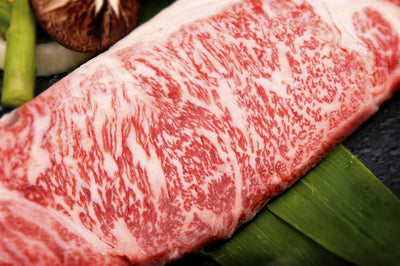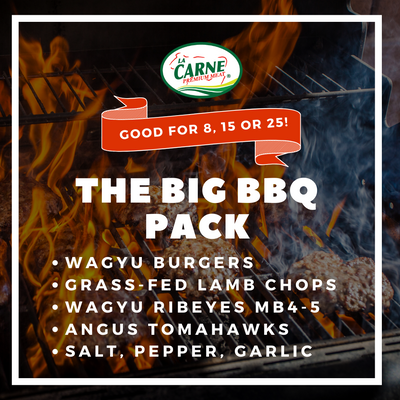The Ultimate Steak Dictionary

Brush up or expand your steak knowledge by browsing through these must-know terms. If you have any questions, feedback or even some more definitions you'd like us to break down, do share with us below!
- Marbling
- The intramuscular fat or fat within muscles in beef or lamb.
- The higher the marbling grade, the more evenly and finely distributed its fat in the meat. When the fat melts, it moistens and flavors the meat. Producing beef that is higher in marbling takes time, care and attention therefore highly marbled beef is more expensive than beef with little marbling.
- Doneness
- Eating steak rare is perfectly safe, because bacteria resides on the surface of steak. When you sear steak on all surfaces you kill off all the bacteria.

- The hand method is also popular when cooking steak as shown below, to give an idea of how the different levels feel.

- Searing
- Also known as the Maillard reaction or caramelization, it is a chemical reaction between amino acids and reducing sugars that gives browned food its distinctive flavor.
- Basically it's cooking steak on a high heat briefly (time depends on cut thickness) to create this beautifully bronze brown crust usually helped by some freshly cracked salt and pepper.
- Sous Vide
- meaning “under vacuum” in French, sous vide refers to the process of vacuum-sealing food in a bag, then cooking it to a very precise temperature in a water bath. This technique produces results that are impossible to achieve through any other cooking method.
- It is actually very easy to do when you have the machine, as shown here. You can easily do it with a ziplock! Available through Desert Cart online.
- Reverse Sear
- Cooking steak in an oven or sous vide until you achieve the preferred internal temperature and then searing it quickly in a hot pan to get a beautiful color on the beef. It prevents overcooking of steak.
- Since you rest the steak after baking/sous vide-ing, you don't have to rest it after searing and can eat it hot from the pan! Check out this example here.
- Resting
- Letting your steak chill out after cooking it.
- Allowing the meat to stand away from the heat before serving allows the juices, which have been driven to the centre of the meat to redistribute throughout the meat and be reabsorbed. As a result the meat will loose less juice when you cut it and be far more tender and juicy to eat.
-
How?
Take it from the heat and place it on a warm plate or serving platter. Cover the meat loosely with foil. If you cover it tightly with the foil or wrap it in foil, you will make the hot meat sweat and lose the valuable moisture you are trying to keep in the meat. -
How long?
If given the time to rest the meat will lose less juice when you cut it and when you eat it the meat will be juicier and tastier. The time taken to rest will depend on its size. Steaks or chops should stand for 5 minutes (but no less than 3) before serving. A rule of thumb used by some chefs is 1 minute resting time for every 100g of meat.
- Basting
- Basically giving your steak a bath of usually butter, fresh herbs and crushed garlic cloves to moisten and flavor it while cooking, usually with a spoon. Doesn't that sound lovely?
- Wagyu
- Literally means Japanese (Wa) Beef or Cow (Gyu). Wagyu from Japan means beef from any of the four Japanese types of Japanese cattle (Black, Brown, Polled or Shorthorn). 90% of Japanese Wagyu is Japanese Black.
- Wagyu from Australia is Wagyu bred in Australia, initiated by Japanese families. Since Japan is a much smaller country with varying seasons affecting their pastures and temperature in farms, Japan has worked with Australian feedlots for many years to commercialize the production of Wagyu to keep up with the global demand.
- Angus
- Aberdeen Angus is a cattle breed hailing from Scotland. Angus is a superior breed due to its genetics allowing great marbling, tenderness and beefy flavor.
- Certified Angus Beef
- The Certified Angus Beef ® brand is an American label established in 1978, recognizing exceptional Angus beef that is tasty, tender and juicy. They work with family farmers and ranchers to help them raise the very best Angus beef, and monitor its progress through every stage of the journey. Certified Angus Beef LLC is a nonprofit entity owned by the American Angus Association ® and its farmer members.
- Slicing Across the Grain
- Although it seems like a minor issue, it is actually quite the opposite as the way you slice your steak imparts almost 99% of the experience when you eat it. When you slice across the grain it cuts the work that your jaw has to do by almost 80%. Trust us. You'll thank us for it. Consider the below photo of a flank steak:

- Grass-fed
- Cattle fed only grass and pastures.
- Grain-fed/Grain-finished
- Cattle fed with grass first then fed grain for the latter part of their feeding program to enable marbling.
- Wet-aged
- Wet-aging is a relatively recent technique that developed along with advances in plastics and refrigeration. In this process, cuts of beef are vacuum-sealed in plastic and shipped to the market.
- The enzymes still have time to tenderize the meat enough to make it acceptable, and the biggest plus is that there's no weight-loss in the meat due to dehydration.
- Dry-aged
-
Whole cuts of beef are hung in open air at a temperature just above freezing and left to age for several weeks, allowing for a very tender meat with an intense, almost funky flavor.
-
It's expensive as the dehydration that occurs reduces the meat volume, concentrates the meat and changes the texture and flavor. The process takes much time, care and attention as well as space in temperature controlled cabinets/rooms. Also, the surface of the meat usually needs to be trimmed away before the beef is portioned and sold, resulting in further loss of volume.
Thanks for reading, please share your thoughts below! We'd love to hear from you!
- Joan, Culinary Business Manager
Sources:
- http://www.verdefarms.com/rare-medium-or-well-done-the-subtle-differences-of-steak-doneness/
- https://anovaculinary.com/what-is-sous-vide/
- https://www.thekitchn.com/whats-the-difference-dryaging-78737
- http://www.beefandlamb.com.au/Learn/Cooking_tips/Barbecue/How_and_why_we_rest_meat_after_cooking
- https://www.certifiedangusbeef.com/faq.php
- https://www.thekitchenwhisperer.net/2015/10/27/tuesdays-tip-with-the-kitchen-whisperer-cutting-meat-against-the-grain/
- https://www.thekitchn.com/whats-the-difference-dryaging-78737


















Very informative yet casually unindimidating… a great way to bring more meat lovers closer to the wonderful world of fine meats… not just for the fine wine enthusiasts but also for craft beer lovers and hopheads!
Mouth watering piece. Couple of interesting things I can’t wait to try here
Very informative and helpful to meatlovers!
Good read for those who love steaks but doesn’t know much about it!
Leave a comment